October 6, 2014

We had the pleasure of speaking at the Shakespeare Swine Seminar in Ontario, Canada, this past week. There was a lot of good interaction with the producers at the meeting with many questions asked and we will answer several of the questions in the columns we write over the next several months.
The question brought up by several producers at the meeting was about inducing sows and timing of inducing.
To address this question we felt we needed to start looking at gestation length and the range of gestation days. We picked farms from our consulting database that do no or minimal inducing, at 24-plus pigs weaned per mated female per year and had farrowing rate at 85-plus% for the last three years. We feel there is some difference in gestation length by genetics so we picked farms that represented four genetic companies in the data base and used the averages of five farms per company. We looked at services over the last three years. We will not be sharing the names of the genetic companies we used.
We know that inducing has been on the decline the last few years as the larger farms are extending hours that someone is in farrowing attending sows with several farms now at 24/7 in farrowing. If you are a farm smaller than 2,500 sows can you afford that extra labor? Maybe if you can lower stillborns and pre-weaning death loss.
At the Shakespeare Swine Seminar, George Charbonneau, veterinarian, talked about “Keeping Large Litters Alive” and shared the attached two charts. The first one (Picture 1) “Avoid inducing sows earlier than days 115” (Pinilla, Geiger, Kummer, Piva, Schott and Williams (2008) AASV Proceedings) is broken out by day of gestation and the average birth weight of the pigs born. The data show that sows allowed to farrow at day 118 had pigs born at an average weight of 3.7 pounds versus day 113 at 2.9 pounds that is an improvement of birth weight of 0.80 pounds or 0.15 pounds per day. We all know that birth weight affects survivability of pigs and how fast they grow in the finisher phase. The second chart (Picture 2) was “Sows farrowings after day 115 have ‘richer’ colostrum” (Gin et cols. (2008), From Martineau (2009)). This data show the earlier a sow farrows the lower the level of Immunoglobulin G colostrum in the milk for the pigs. We all know that colostrum is needed by every pig so it can survive.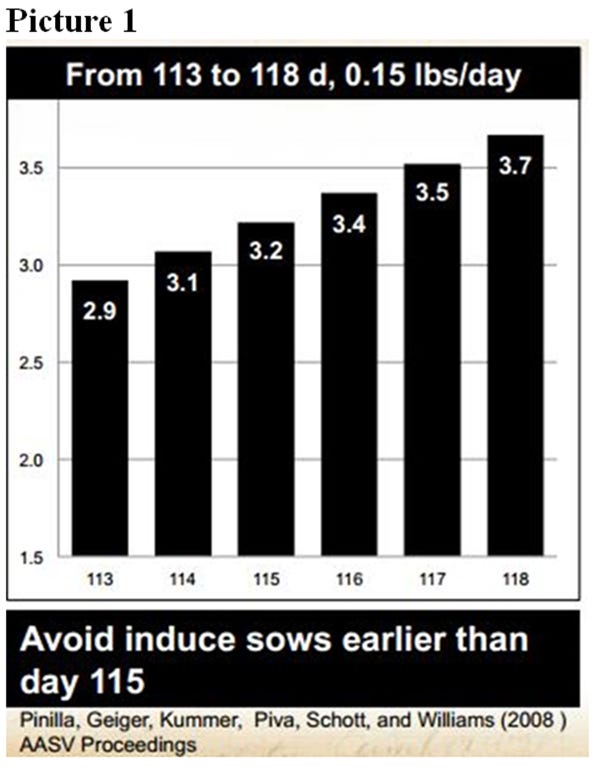
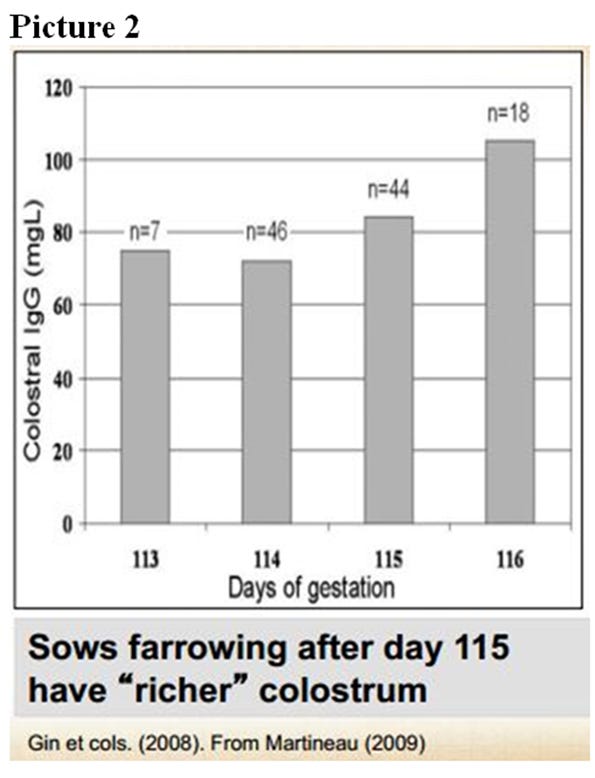 Along with affecting piglet birth weight and colostrum we know that if a sow is induced too early that she will have smaller pigs, sometimes pigs that have lower viability, more farrowing difficulties, and some sows that do not have or produce enough milk.
Along with affecting piglet birth weight and colostrum we know that if a sow is induced too early that she will have smaller pigs, sometimes pigs that have lower viability, more farrowing difficulties, and some sows that do not have or produce enough milk.
So to show there are differences in average gestation length and a lot of variation in days we selected four different genetic companies and broke the data out by parity and range in gestation length. In Chart 1 and Table 1, the average gestation length is 115.9 days with range of <110 to >122. We see in Chart 1 a normal bell shaped curve with 94.3% of sows farrowing days 114 day 118 with 34.6% being at average of 116 days. You will notice by parity that the P0 females at 115.7 days to 116.1 for P7+ females. 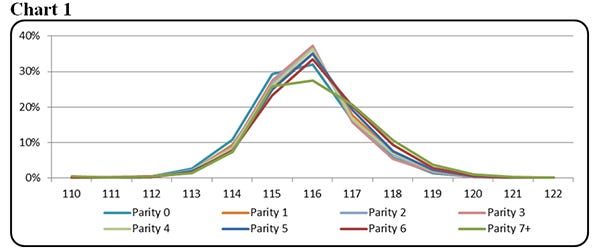
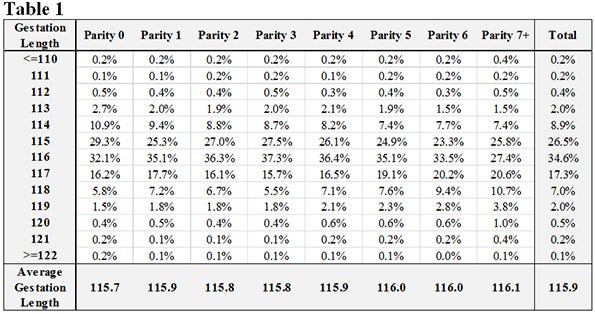 In Chart 2 and Table 2, average gestation length is higher at 116.5 days with 93.4% being in the range of 114 to 118 days. At the average of 116 days there were 34.1% of the farrowings. It was interesting to see very little variation in gestation length by parity.
In Chart 2 and Table 2, average gestation length is higher at 116.5 days with 93.4% being in the range of 114 to 118 days. At the average of 116 days there were 34.1% of the farrowings. It was interesting to see very little variation in gestation length by parity. 
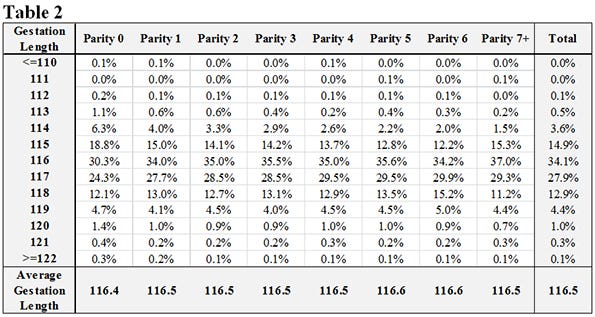
The company in Chart 3 and Table 3 shows a drop of 1.1 days with an average of 115.4 days. These farms also had a range of gestation of <110 to >122 days. Even with an average gestation length 1.1 days less that, company 2 still had 95.4% of the farrowings in the range of 114 to 118 days with 33.1% at the average of 116 days. 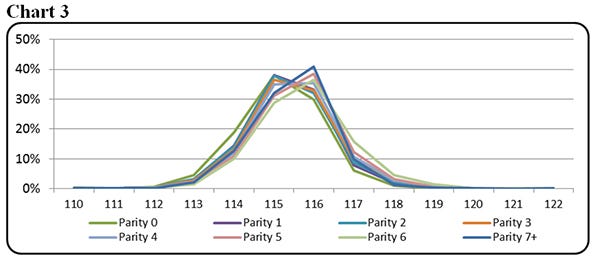
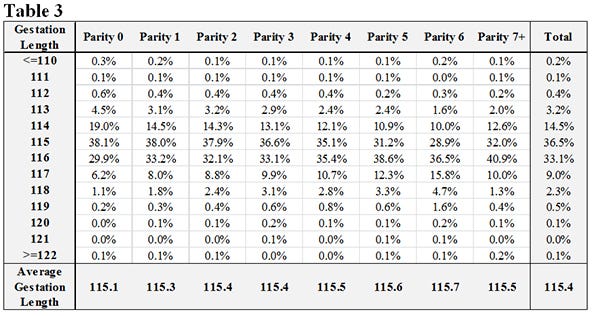 The company in Chart 4 and Table 4 had the shortest average gestation length of 115.3 days with only 90.4% in the range of 114 to 118 days with a drop to only 22.3% day 116. The highest day farrowing was day 115 at 35.2%. You will also note that there were no sows over day 122 and more farrowing <110 days.
The company in Chart 4 and Table 4 had the shortest average gestation length of 115.3 days with only 90.4% in the range of 114 to 118 days with a drop to only 22.3% day 116. The highest day farrowing was day 115 at 35.2%. You will also note that there were no sows over day 122 and more farrowing <110 days.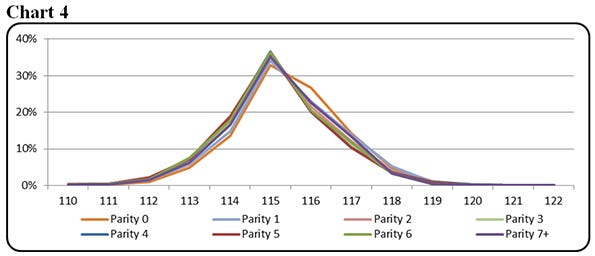
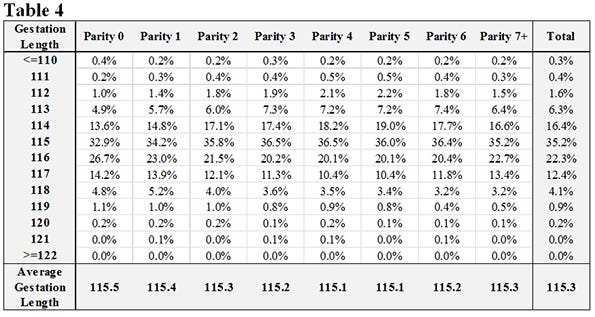
So we know that 90-plus% of the sows farrow day 114 to 118, there is a 1+ days difference in average gestation length, and range is <110 days to >122 days. That is why inducing is hard to do and the outcome is quite varied. There is still a place for some inducing:
To finish out a farrowing room.
To induce those gilts that are at 116-plus days.
To induce some problem sows so that they would farrow when someone is in the farrowing room that might help reduce stillborns and save more pigs.
What day do you use when you induce sows? You need to talk to your veterinarian about what day is best for your farm. If you are doing minimal inducing, you can look at the gestation length of each individual sow to help you make that decision.
If you are a small farm what management changes can you make to attend more sows farrowing?
Consider batch farrowing so that every few weeks there are a large number of sows to farrow.
Move to weaning one time per week so more sows farrow together.
If you move to once-per-week weaning and want more sows to farrow during the week, consider weaning on Sunday or Monday. This will move most of the farrowings to Monday through Friday when more people are on the farm.
Induce on selected days when there are large numbers of sows to farrow. If you do this you may need to have more labor available to farrow those extra litters. It looks like it takes one person per 10 sows farrowing.
Where is your farm at on inducing? We hope this information is of value.
SMS Production Index
Table 5 provides the 52-week rolling averages for 11 production numbers represented in the SMS Production Index. The numbers are separated by 90-100%, the 70-90%, the 50-70%, the 30-50% and the 0-30% groups. We also included the 13-week, 26-week and 12-quarter averages. These numbers represent what we feel are the key production numbers to look at to evaluate the farm’s performance.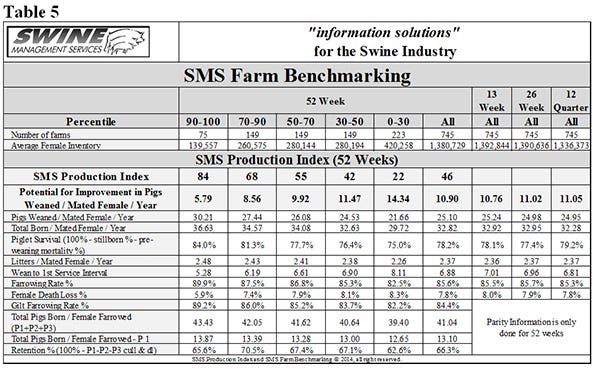
At SMS, our mission statement is to provide “Information solutions for the swine industry”. We feel with the creation of the new Farm Benchmarking database we now have more detailed information to share with the swine industry. If your farm would like to be part of the Farm Benchmarking database, or if you have suggestions on production areas to write columns about, e-mail or call us. We enjoy being a part of the National Hog Farmer Weekly Preview team.
If you have questions or comments about these columns, or if you have a specific performance measurement that you would like us to write about, please contact [email protected] or [email protected].
Previous Production Preview columns can be found at www.nationalhogfarmer.com.
You May Also Like



